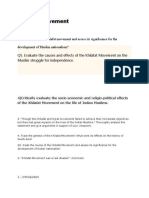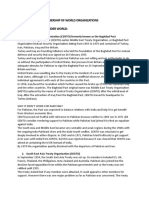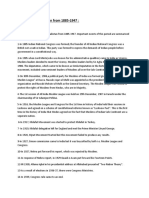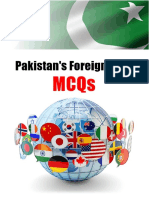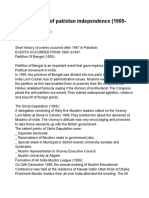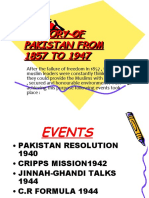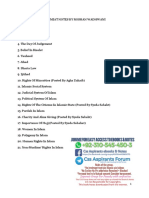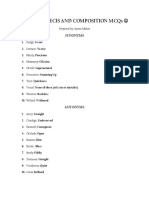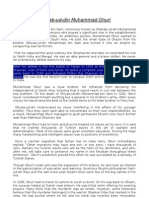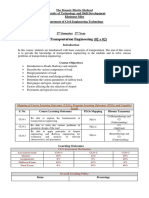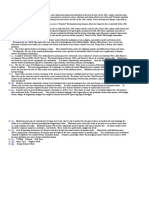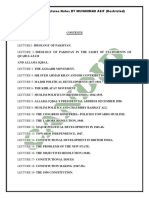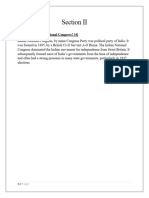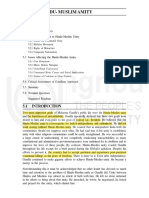Professional Documents
Culture Documents
Khilafat Movement: The Rise of Muslim Nationalism in India (1919-1924)
Khilafat Movement: The Rise of Muslim Nationalism in India (1919-1924)
Uploaded by
Khalil AhmedOriginal Description:
Original Title
Copyright
Available Formats
Share this document
Did you find this document useful?
Is this content inappropriate?
Report this DocumentCopyright:
Available Formats
Khilafat Movement: The Rise of Muslim Nationalism in India (1919-1924)
Khilafat Movement: The Rise of Muslim Nationalism in India (1919-1924)
Uploaded by
Khalil AhmedCopyright:
Available Formats
Khilafat Movement: The Rise of Muslim
Nationalism in India (1919-1924)
October 17, 1919: Khilafat Day
March 19 1920: Khilafat Day (Again)
Leaders: Mohammed Ali Juhar, Shaukat Ali, Maulana Abul Kalam Azad, Hakim Ajmal
Khan and Hasrat Mohani, Sheikh ul Hind-------
The Movement
The Khilafat Movement was a pan-Islamic, political protest campaign launched by Muslims in
British India to influence the British Government and to protect the Ottoman Empire during the
aftermath of First World War. The aims of this movement were:
To keep the institution of Khilafat intact and Khalifah to carry out the business of
government as usual
Restoration of Turkey’s grace as it possessed before and during World War – I, and
no change to occur in the boundaries of Turkey.
The sanctity ( )دقتسof Makkah and Madina should be maintained and non-Muslim
forces should not be allowed to enter in these two sacred cities.
To protect the Holy place of Turkey
To restore the Territories of Turkey
To restore the Ottoman Empire
Note: Use only one
Khilafat conferences
First Khilafat Conference: November 1919 in Delhi
Second Khilafat Conference: December 1919, Amritsar.
Third Khilafat Conference: February 1920, Bombay
Activities of Movement
Delegations were sent to Britain and other European countries to convey the feelings of
the Muslims to the governments.
Doctors, nurses and medicines were dispatched to Turkey for the treatment of wounded
Turkish soldiers.
By: Dr. Syeda Farzana Bukhari ……………………………………………………………..…………………….Read Right Institute
A large amount of money, gold and silver was collected in the general meetings to give
financial aid to Turkey.
Large processions were arranged, protest meetings were held and strikes were observed
in all big and small cities in the sub-continent. The Muslim volunteers presented
themselves to the police for arrests. All leaders were sent behind the bars but the
momentum of movement could not be diminished.
The role of Muslim journalism was tremendous. Zamindar of Zafar Ali Khan, Al-Hilal of
Azad and Comrade and Hamdard of Jauhar played vital roles in the movement. They
inculcated a sense of sacrifice among the Muslims.
Joint Venture/ Siamese Twins: The Non-Cooperation movement and the
Khilafat movement
The Khilafat Movement and the Congress Non-Cooperation Movement merged into one
nationwide movement by the year-end of 1920. The Indian National Congress supported the
Muslims’ contention and under the guidance of Mahatma Gandhi, a non-violent non-cooperation
campaign was launched on 1st August 1920. Gandhi espoused ( )ااختنبرکناthe Khilafat cause, as he
saw in it the opportunity to rally Muslim support for nationalism. Ali brothers and their allies, in
turn, provided the non-cooperation movement with some of its most enthusiastic followers.
Collapse of the Movement
The combined Khilafat Non-Cooperation movement was the first all-India agitation against
British rule. It saw an unprecedented degree of Hindu-Muslim cooperation and it established
Gandhi and his technique of non-violent protest (satyagraha) at the center of the Indian
nationalist movement. Mass mobilization using religious symbols was remarkably successful,
and the British Indian government was shaken. In late 1921, the government moved to suppress
the movement. The leaders were arrested, tried, and imprisoned. Gandhi suspended the Non-
Cooperation movement in early 1922. Turkish nationalists dealt the final blow to the Khilafat
movement by abolishing the Ottoman sultanate in 1922 and the caliphate in 1924.
Events/Incidents led to Failure
Hijrat Movement 1920
Maulana Abul Kalam Azad and Maulana Abdul Bari issued a fatwa declaring India as “Dar-ul-
Harab” (Home of War). They urged the Muslims migrate to Afghanistan in religious protest
against the British policy. *Popularity of the movement can be determined from the fact that
more than thirty thousand Muslims had left for Kabul by the second week of August 1920. In the
beginning the Afghanistan government welcomed Indian Muslims but later on closed down their
frontiers when they found flood of refugees were coming would be too difficult for them to
By: Dr. Syeda Farzana Bukhari ……………………………………………………………..…………………….Read Right Institute
handle. Even those who have managed to enter successfully were spending miserable life and
disgusted because Afghanistan was a poor country and facing many internal problems. The
refugees came across so many hardships and soon they were force to take a journey back home.
The retreat resulted in a heavy loss of life due to the bad weather and disease. Some of the
refugees went to Soviet Union and Europe.
Moplah Uprising/ Moplah Rebellion of 1921
The Khilafat meetings in Malabar incited communal feelings among the Moplahs and it became
a movement directed against the British as well as the Hindu landlords of Malabar. There was
large-scale violence that saw systematic persecution of Hindus and British officials. Many homes
and temples were destroyed. From August 1921 till about the end of the year, the rebels had
under their control large parts of Malabar. By the end of the year, the rebellion was crushed by
the British who had raised a special battalion, the Malabar Special Force for the riot. In
November 1921, 67 Moplah prisoners were killed when they were being transported in a closed
freight wagon. They died of suffocation. This event is called the Wagon Tragedy.
Arrest and imprisonment of the leaders
The British government also arrested the leaders of the Khilafat Movement on account of their
anti-government speeches and the movement was deprived of their effective and strong
leadership. Both Hindu and Muslim leaders were imprisoned for several years. About 30000
workers all over India were put in jails The Khilafat Movement came to an end when thousands
of Indians were put behind the bar. The leaders, in spite of their best efforts, could not maintain
the Hindu-Muslim Unity. Far-sighted people like Mr. Jinnah and Allama Iqbal did not support
the movement.
The Chauri Chaura Incident: A Death Blow to Khilafat Movement
The Chauri Chaura incident took place on 4 February 1922 at Chauri Chaura in the Gorakhpur
district of Uttar Pradesh. A large group of protesters participating in the non-cooperation
movement were fired upon by the police. In retaliation the demonstrators attacked and set fire to
a police station, killing all of its occupants. The incident led to the death of three civilians and 22
policemen. Mahatma Gandhi, who was strictly against violence, halted the non-cooperation
movement on the national level on 12 February 1922, as a direct result of this incident. In spite
of Gandhi's decision, 19 arrested demonstrators were sentenced to death and 14 to imprisonment
for life by the British colonial authorities.
By: Dr. Syeda Farzana Bukhari ……………………………………………………………..…………………….Read Right Institute
Abolition of the Caliphate/ Khilafat in Turkey: A Finishing Blow
In 1924, Kamal Ataturk set up a government on democratic basis in Turkey by abolishing
Khilafat as a system of government which served a finishing blow to Khilafat Movement in India
and people had lost whatever interest that they had in the movement. The most important reason
for the failure of the Khilafat Movement was the abolition of the institution of the Caliphate by
the Turks themselves. Mustafa Kamal Ataturk ¸the Turkish leader established a modern
democratic government in Turkey with a properly elected parliament. In this set up the caliph &
the seat of the Caliphate had no place. The caliph was deposed and exiled in 1924. Muslims in
India had nothing to fight for and the Khilafat Movement ended in failure in 1924. Therefore, the
abolition of the institution of the caliphate in 1924 was the main reason for the failure of the
Khilafat Movement.
Quotations:
The British government treated the Indian Khilafat delegation of 1920, headed by Muhammad
˓Ali, as quixotic pan-Islamists, and did not change its policy toward Turkey. The delegation
insisted the Britain not to punish Turkey but the Prime Minister Lloyd George said:
“Austria has had justice; Germany has had
justice-pretty terrible justice –why should Turkey
escape”?
(Lloyd George, 1920)
This was in violation of the earlier pledge of the British Prime Minister Lloyd George
who had declared:
“Nor are we fighting to deprive Turkey of its capital, or of the
rich and renowned lands of Asia Minor which are
predominantly Turkish in race … We do not challenge the
maintenance of the Turkish race, with its capital at
Constantinople.”
(Lloyd George, the Prime Minister of the Great Britain, 1918)
James Wynbrandt says his book, A Brief History of Pakistan:
As the end of World War I approached, the dissolution of the
Ottoman Empire became imminent. Muslims of South Asia
mounted an effort to save the empire, joining in the Khilafat
movement.
(James Wynbrandt , A Brief History of Pakistan pg.141)
By: Dr. Syeda Farzana Bukhari ……………………………………………………………..…………………….Read Right Institute
Quaid-e-Azam and the Non-Cooperation movement and the Khilafat
movement
The Quaid felt that the Indians should fight Imperialism constitutionally instead. The Nagpur
session, which was thirty-fifth Congress, was held in December 1920. Gandhi’s non-cooperation
movement had been approved at a special session at Amritsar and during the Nagpur session,
Jinnah was the only person who had the courage to openly oppose the resolution proposed by
Gandhi, despite strong opposition by the crowd. The Quaid said:
“… the weapon will not destroy the British Empire… it is neither
logical nor is it politically sound or wise, nor practically capable
of being put in execution.”
Jinnah learnt a lot from the Khilafat movement. It disillusioned him with the Congress and the
British rulers and strengthened his faith to work for the interests of the Muslims. He worked hard
to bring the Muslims out of their demoralized state of mind and reorganize them under the
banner of the Muslim League.
By: Dr. Syeda Farzana Bukhari ……………………………………………………………..…………………….Read Right Institute
You might also like
- Pak StudyDocument61 pagesPak StudyKainat BilalNo ratings yet
- Spread of Islam DBQ 3Document5 pagesSpread of Islam DBQ 3Chris ChiangNo ratings yet
- Pak Studies Paper 2020Document36 pagesPak Studies Paper 2020Shan Ali Shah100% (1)
- Be Hell For, Tanvir AnjumDocument22 pagesBe Hell For, Tanvir AnjumtanvirNo ratings yet
- CBSE BOARD Objective Questions Exam 2019 PDFDocument75 pagesCBSE BOARD Objective Questions Exam 2019 PDFTaroonNo ratings yet
- Css NotesDocument90 pagesCss NotesWaqas AmjadNo ratings yet
- CSS/PMS ANSWERS On Khilafat MovementDocument66 pagesCSS/PMS ANSWERS On Khilafat MovementSayed Adnan ShahNo ratings yet
- Khilafat Movement-Cripss Mission (1919-1942)Document7 pagesKhilafat Movement-Cripss Mission (1919-1942)MahamIsmailNo ratings yet
- 20-04-2021 One Paper MCQS DoseDocument11 pages20-04-2021 One Paper MCQS DoseRaja NafeesNo ratings yet
- History of Pakistan Independence (1900-1947)Document6 pagesHistory of Pakistan Independence (1900-1947)Asif Awan100% (1)
- Hist Topic 20 Cripps Mission 1942 PDFDocument4 pagesHist Topic 20 Cripps Mission 1942 PDFabubakarNo ratings yet
- Pakistan and International OrganizationsDocument4 pagesPakistan and International Organizationsfaizakkhan100% (1)
- Constitutional History of Pakistan 2Document7 pagesConstitutional History of Pakistan 2Mohsin Ali Shah100% (1)
- Shah WaliullahDocument3 pagesShah Waliullahroots schoolsystem theNo ratings yet
- History of Pakistan From 1885 t0 1947Document2 pagesHistory of Pakistan From 1885 t0 1947Umar HayatNo ratings yet
- Pakistan Foreign Policy MCQs PDFDocument9 pagesPakistan Foreign Policy MCQs PDFmunim matinNo ratings yet
- Indo Pak 2 (1857 Onwards)Document16 pagesIndo Pak 2 (1857 Onwards)Gohar IrfanNo ratings yet
- Short History of Pakistan IndependenceDocument13 pagesShort History of Pakistan IndependenceNadeem AfzalNo ratings yet
- MCQ SsssssDocument20 pagesMCQ SsssssAleeza AliNo ratings yet
- Naib Tehsildar MCQ'S: PART-2Document10 pagesNaib Tehsildar MCQ'S: PART-2Zurriat LastNo ratings yet
- William III and Mary IIDocument11 pagesWilliam III and Mary IINahir agostinaNo ratings yet
- British History MCQsDocument27 pagesBritish History MCQsMuhammad BilalNo ratings yet
- History of Pakistan From 1857 To 1947Document21 pagesHistory of Pakistan From 1857 To 1947Asma BatoolNo ratings yet
- School Project Rowlatt ActDocument15 pagesSchool Project Rowlatt ActP. ChaudhuriNo ratings yet
- Islamiat Notes by Roshan Wadwani PDFDocument151 pagesIslamiat Notes by Roshan Wadwani PDFJaffar Mastoi100% (1)
- Muhammad Bin Qasim ScribdDocument16 pagesMuhammad Bin Qasim Scribdarunastro100% (2)
- Pakistan Affairs Solved McqsDocument13 pagesPakistan Affairs Solved McqsTahir NabeelNo ratings yet
- BPSC Kohli and Naseem SB QuestionDocument37 pagesBPSC Kohli and Naseem SB QuestionAli JavedNo ratings yet
- War of IndependenceDocument8 pagesWar of IndependenceFahadNo ratings yet
- Nehru Report (1928) and Simon Commission (1927) - G7-Pakistan StudiesDocument2 pagesNehru Report (1928) and Simon Commission (1927) - G7-Pakistan StudiesShareena Iftikhar Chaudhry100% (1)
- About EBDODocument1 pageAbout EBDOwalod87606100% (1)
- Hist Topic 16 The Round Table ConferencesDocument5 pagesHist Topic 16 The Round Table ConferencesRaiyaan BawanyNo ratings yet
- Major Political Developments 1857-1918 - Pakistan Affairs Notes For CSS - PMSDocument6 pagesMajor Political Developments 1857-1918 - Pakistan Affairs Notes For CSS - PMSSajjad Ahmed MughalNo ratings yet
- PA Notes by Ayesha YounasDocument55 pagesPA Notes by Ayesha YounasMazhar HussainNo ratings yet
- Xeric: Indo-Pak History Paper-I (2006)Document1 pageXeric: Indo-Pak History Paper-I (2006)Bilawal DahriNo ratings yet
- History of Indo-Pak MCQs (History of Subcontinent Before Islam)Document12 pagesHistory of Indo-Pak MCQs (History of Subcontinent Before Islam)AhmadRaza BhattiNo ratings yet
- Solved MCQs of Compulsory Subjects (CSS CE-2017)Document5 pagesSolved MCQs of Compulsory Subjects (CSS CE-2017)Shabnam memon100% (3)
- Simon Commission Notes PDFDocument7 pagesSimon Commission Notes PDFHamnaNo ratings yet
- Pakistan Affairs Fill in The Blanks PDFDocument8 pagesPakistan Affairs Fill in The Blanks PDFmahNo ratings yet
- Freedom Movement 1947Document9 pagesFreedom Movement 1947sibtain hassanNo ratings yet
- Major Political Developments in 1945-46 - Pakistan Affairs Notes For CSS - PMSDocument5 pagesMajor Political Developments in 1945-46 - Pakistan Affairs Notes For CSS - PMSKul SumNo ratings yet
- CSS Current Affair Past Paper 2012Document8 pagesCSS Current Affair Past Paper 2012Mohsin GNo ratings yet
- A Critical Research of The Bengal Partition AbstractDocument9 pagesA Critical Research of The Bengal Partition AbstractArindom BaruaNo ratings yet
- Indo-Pak HistoryDocument37 pagesIndo-Pak Historysarfraz_mehmood100% (1)
- Sheikh Ahmad Sirhindi: ReligiousDocument4 pagesSheikh Ahmad Sirhindi: ReligiousSaima Imran KhanNo ratings yet
- The Constitution of 1962 - Important MCQs For Pakistan StudiesDocument4 pagesThe Constitution of 1962 - Important MCQs For Pakistan StudiesKIRAN BUTT50% (2)
- Pak-China RelationsDocument3 pagesPak-China RelationsThe CSS Point100% (1)
- Of Pakistan in The Light of Statements of Quaid-e-Azam & Allama IqbalDocument16 pagesOf Pakistan in The Light of Statements of Quaid-e-Azam & Allama Iqbalmahnoor javaidNo ratings yet
- Muslims Political StruggleDocument33 pagesMuslims Political StruggleJaveria AwanNo ratings yet
- Shahab Ud Din Muhammad GuriDocument1 pageShahab Ud Din Muhammad GuriMuhammad TahirNo ratings yet
- Simla AgreementDocument3 pagesSimla Agreementdnmq86No ratings yet
- Pakistan Affairs MCQS in PDFDocument8 pagesPakistan Affairs MCQS in PDFatifNo ratings yet
- A Solution To The Problems Facing The Sub-Continent in The Years 1940-1947Document10 pagesA Solution To The Problems Facing The Sub-Continent in The Years 1940-1947abdullah khalilNo ratings yet
- Pakistan StudiesDocument29 pagesPakistan StudiesTalha IrfanNo ratings yet
- MCQ Bank For Pak Studies 2024Document12 pagesMCQ Bank For Pak Studies 2024SARMAD ALINo ratings yet
- PMS PapersDocument5 pagesPMS PapersAfzal KhanNo ratings yet
- Kashmir Issue Past Present FutureDocument30 pagesKashmir Issue Past Present FutureThomos ShelbyNo ratings yet
- English Precis and Composition 2019 PaperDocument2 pagesEnglish Precis and Composition 2019 PaperThe CSS Point56% (9)
- Hazrat Mujadid Alf Sani: Sheikh Ahmed SirhindiDocument17 pagesHazrat Mujadid Alf Sani: Sheikh Ahmed Sirhindiyaseen ejazNo ratings yet
- IndoPak History 1857-1947Document31 pagesIndoPak History 1857-1947Kashani DrShoaibNo ratings yet
- Ayub Khan Notes Section 3Document8 pagesAyub Khan Notes Section 3Rickest RickNo ratings yet
- Khilafat MovementDocument14 pagesKhilafat MovementSumair S.No ratings yet
- Lab Mannual PRC Final 1Document32 pagesLab Mannual PRC Final 1Khalil AhmedNo ratings yet
- Thiem EqDocument6 pagesThiem EqKhalil AhmedNo ratings yet
- Unithydrograph 171220165742Document20 pagesUnithydrograph 171220165742Khalil AhmedNo ratings yet
- Floods PDFDocument21 pagesFloods PDFKhalil Ahmed100% (1)
- TransportationDocument19 pagesTransportationKhalil AhmedNo ratings yet
- Course Outline Transportation EngineeringDocument3 pagesCourse Outline Transportation EngineeringKhalil AhmedNo ratings yet
- Pakistan Study Set 10Document14 pagesPakistan Study Set 10Khalil AhmedNo ratings yet
- Vertical AlignmentDocument42 pagesVertical AlignmentKhalil AhmedNo ratings yet
- Viva Voice - Sir Mukesh Notes Edited by MuzamilDocument8 pagesViva Voice - Sir Mukesh Notes Edited by MuzamilKhalil AhmedNo ratings yet
- ModernismDocument2 pagesModernismKhalil AhmedNo ratings yet
- Pakistan Study Set 08Document14 pagesPakistan Study Set 08Khalil AhmedNo ratings yet
- PrepositionDocument8 pagesPrepositionKhalil AhmedNo ratings yet
- Decline of Muslim Empire PDFDocument4 pagesDecline of Muslim Empire PDFKhalil AhmedNo ratings yet
- Mahatma Gandhi and The Nationalist Movement: ThirteenDocument30 pagesMahatma Gandhi and The Nationalist Movement: ThirteenBarnali DuttaNo ratings yet
- Pakistan Studies Notes-1Document80 pagesPakistan Studies Notes-1Junaid AzizNo ratings yet
- Pak StudyDocument94 pagesPak StudyMuhammad ZohaibNo ratings yet
- Importance of Khilafat MovementDocument1 pageImportance of Khilafat Movementmrtweets50% (2)
- National Movement-Gandhian Era-NoteDocument3 pagesNational Movement-Gandhian Era-NoteRakshit RaghavendraNo ratings yet
- Geneal Studies: World Heritage Sites in IndiaDocument35 pagesGeneal Studies: World Heritage Sites in IndiaguyhotsterNo ratings yet
- National Unity and Freedom MovementDocument5 pagesNational Unity and Freedom MovementIMRAN MUSHTAQNo ratings yet
- Fahad PST 1 Section 2Document63 pagesFahad PST 1 Section 2Mariam AfzalNo ratings yet
- Nationalism in India Part 1Document5 pagesNationalism in India Part 1Himanshu Dixit0% (1)
- Hindu Muslim UnityDocument37 pagesHindu Muslim UnityNandini DiwakarNo ratings yet
- 1a Order in Modern Indian HistoryDocument4 pages1a Order in Modern Indian HistorynvamsavardhanNo ratings yet
- Early History and Pakistan MovementDocument31 pagesEarly History and Pakistan MovementShahriar HasanNo ratings yet
- 2059/1 Section 2 + LanguagesDocument48 pages2059/1 Section 2 + LanguagessNo ratings yet
- حکیم اجمل خان PDFDocument26 pagesحکیم اجمل خان PDFAbdurrahmanNo ratings yet
- Khilafat Movement LaunchedDocument2 pagesKhilafat Movement LaunchedAariz AsherNo ratings yet
- Nationalism in IndiaDocument13 pagesNationalism in India7A04Aditya MayankNo ratings yet
- History: A. Statistics at A GlanceDocument27 pagesHistory: A. Statistics at A GlanceT.K. MukhopadhyayNo ratings yet
- 'Non'Violent Gandhi, Article 1Document10 pages'Non'Violent Gandhi, Article 1Anurupa CinarNo ratings yet
- Pakistan Studies Past Paper QuestionsDocument30 pagesPakistan Studies Past Paper QuestionsPainduNo ratings yet
- I Humbly Acknowledge Some Answers of A Person. I Don't Know Who He Is But Credit To Him As WellDocument32 pagesI Humbly Acknowledge Some Answers of A Person. I Don't Know Who He Is But Credit To Him As WellGulraiz BalochNo ratings yet
- Indian History and Post IndependenceDocument104 pagesIndian History and Post IndependenceDarshan KanganeNo ratings yet
- Hindu Muslim Unity Quiz!!Document3 pagesHindu Muslim Unity Quiz!!Mahnoor FatimaNo ratings yet
- Research AssignmentDocument4 pagesResearch AssignmentAusaf AhmedNo ratings yet
- Modern History MindmapDocument7 pagesModern History MindmapShudhakar KumarNo ratings yet
- 10th Social ScienceDocument62 pages10th Social ScienceHuzaif SajadNo ratings yet
- My Notes (PLZ Check) - Page 2 - CSS ForumsDocument13 pagesMy Notes (PLZ Check) - Page 2 - CSS ForumsĀżiż100% (1)
- Mahatma Gandhi and The National MovementDocument18 pagesMahatma Gandhi and The National MovementManas KhoslaNo ratings yet






